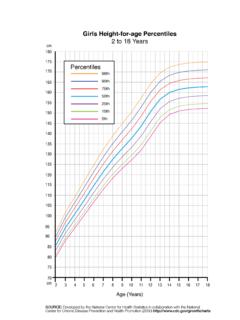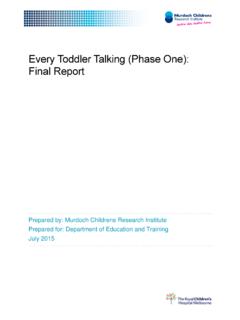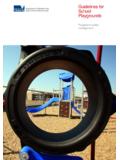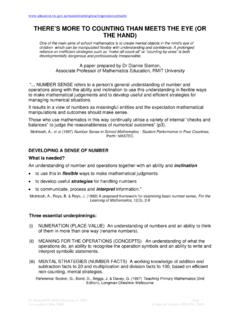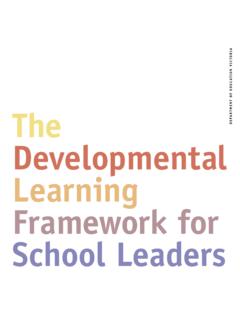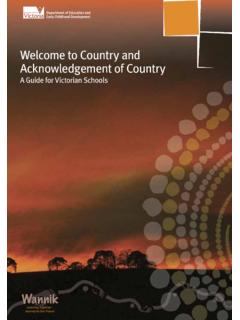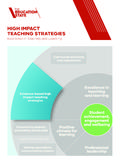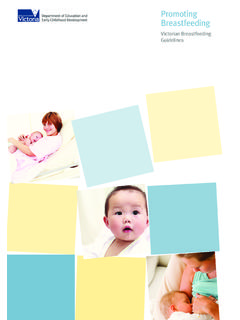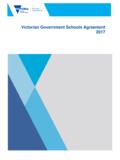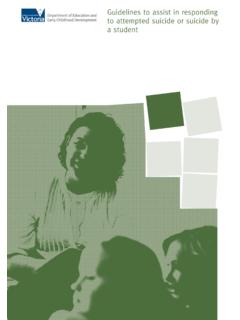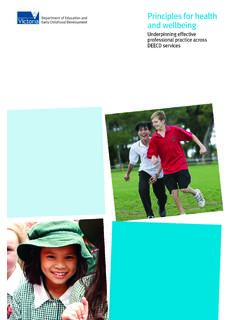Transcription of VICTORIAN EARLY YEARS LEARNING CHILDREN AND …
1 VICTORIAN EARLY YEARS LEARNING AND DEVELOPMENT FRAMEWORK FOR ALL CHILDREN FROM BIRTH TO EIGHT YEARSACKNOWLEDGEMENT OF COUNTRYThe Department of Education and Training (Victoria) and the VICTORIAN Curriculum and Assessment Authority respectfully acknowledge Aboriginal people as the Traditional Owners of the land and waters now known as Victoria. We acknowledge the VICTORIAN Aboriginal Elders and recognise their central place as knowledge holders and teachers across EARLY YEARS LEARNING honour this Acknowledgement throughout the VICTORIAN EARLY YEARS LEARNING and Development Framework. We recognise and respect Aboriginal cultures and their unique place in Victoria s past, present and future. LEARNING about Aboriginal cultures and valuing the place of Aboriginal people is essential to understanding and implementing the VICTORIAN EARLY YEARS LEARNING and Development Framework, based on the principles of equity and human by the Department of Education and TrainingMelbourne 2016 State of Victoria (Department of Education and Training) 2016 The copyright in this document is owned by the State of Victoria (Department of Education and Training), or in the case of some materials, by third parties (third party materials).
2 No part may be reproduced by any process except in accordance with the provisions of the Copyright Act 1968, the National Education Access Licence for Schools (NEALS) (see below) or with educational institution situated in Australia which is not conducted for profit, or a body responsible for administering such an institution may copy and communicate the materials, other than third party materials, for the educational purposes of the respectfully sought and were given approval for Acknowledgement of Country by Aunty Joy Wandin Murphy, Senior Elder of the Wurundjeri by the Department of Education and Training, 2 Treasury Place, East Melbourne, Victoria, 3002. ISBN: 978-0-7594-0800-5 CONTENTSTHE FRAMEWORK: VISION AND PURPOSE 2 PROMOTING CHILDREN S LEARNING AND DEVELOPMENT (BIRTH TO EIGHT YEARS ) 2 WHY BIRTH TO EIGHT YEARS ?
3 2A FRAMEWORK FOR ALL CHILDREN IN VICTORIA 4 LEARNING AND DEVELOPMENT PATHWAYS 6 USING THE VEYLDF 6 PRACTICE PRINCIPLES FOR CHILDREN S LEARNING AND DEVELOPMENT 7 REFLECTIVE PRACTICE 8 PARTNERSHIPS WITH FAMILIES 9 HIGH EXPECTATIONS FOR EVERY child 10 RESPECTFUL RELATIONSHIPS AND RESPONSIVE ENGAGEMENT 11 EQUITY AND DIVERSITY 12 ASSESSMENT FOR LEARNING AND DEVELOPMENT 13 INTEGRATED TEACHING AND LEARNING APPROACHES 14 PARTNERSHIPS WITH PROFESSIONALS 16 EARLY YEARS LEARNING AND DEVELOPMENT OUTCOMES 17 OUTCOME 1: CHILDREN HAVE A STRONG SENSE OF IDENTITY 18 OUTCOME 2: CHILDREN ARE CONNECTED WITH AND CONTRIBUTE TO THEIR WORLD 19 OUTCOME 3: CHILDREN HAVE A STRONG SENSE OF WELLBEING 20 OUTCOME 4: CHILDREN ARE CONFIDENT AND INVOLVED LEARNERS 21 OUTCOME 5: CHILDREN ARE EFFECTIVE COMMUNICATORS 22 SUPPORTING CHILDREN S TRANSITIONS 23 WHAT DOES EFFECTIVE TRANSITION LOOK LIKE?
4 24 WHO IS INVOLVED IN THE PROCESS OF TRANSITION? 24 SUPPORTING CHILDREN S LEARNING AND DEVELOPMENT THROUGH TRANSITIONS 25 TRANSITION: A POSITIVE START TO SCHOOL INITIATIVE 25 CONCLUSION 26 APPENDICES 27 OVERVIEW 27 APPENDIX 1: OVERVIEW OF THE ROLES OF EARLY CHILDHOOD PROFESSIONALS SUPPORTING YOUNG CHILDREN AND FAMILIES (BIRTH TO EIGHT YEARS ) 28 APPENDIX 2: OVERVIEW OF EARLY CHILDHOOD services (BIRTH TO EIGHT YEARS ) 30 APPENDIX 3.
5 OVERVIEW OF RESOURCES THAT SUPPORT BEST PRACTICE OF EARLY YEARS PROFESSIONALS 30 APPENDIX 4: BIBLIOGRAPHY 31 APPENDIX 5: GLOSSARY 35 VICTORIAN EARLY YEARS LEARNING AND DEVELOPMENT FRAMEWORK - THREE ELEMENTS 38 ATTACHMENT 1: ILLUSTRATIVE MAPS FROM THE VEYLDF TO THE VICTORIAN CURRICULUM F - 10 392 VICTORIAN EARLY YEARS LEARNING AND DEVELOPMENT FRAMEWORKTHE FRAMEWORK: VISION AND PURPOSEWHY BIRTH TO EIGHT YEARS ?Research over the past few decades has revealed how the human brain is biologically primed for LEARNING from birth. The EARLY childhood period of CHILDREN s lives has a profound impact on their LEARNING and development for the long term.
6 From birth to eight YEARS , CHILDREN s developing brains undergo rapid change. This is when CHILDREN have the greatest opportunities to develop neural pathways for LEARNING and are also most vulnerable to negative experiences. Research underscores the imperative for comprehensive and integrated systems that support CHILDREN s LEARNING and development, health and wellbeing in partnership with families. Emphasis is placed on continuity of LEARNING for young CHILDREN as they move between various settings in the EARLY YEARS , including home, EARLY childhood services and school. An informed understanding of the science of EARLY LEARNING and development guides adults on what CHILDREN need to thrive and the systems that best support this. BIRTH TO THREE YEARSR esearch also demonstrates the importance of the first three YEARS of life in shaping LEARNING and development.
7 From birth, EARLY experiences and relationships influence CHILDREN s long term outcomes and life chances. This includes the development of executive functioning and the capacity to experience, regulate and express emotion, to form close, secure and satisfying relationships and to explore, discover and learn about themselves and the world around them (Institute of Medicine, 2015; AIHW, 2015). This is important foundational knowledge for all EARLY childhood professionals to understand and apply in their work with families and CHILDREN across birth to eight CHILDREN S LEARNING AND DEVELOPMENT: BIRTH TO EIGHT YEARSThe VICTORIAN EARLY YEARS LEARNING and Development Framework (VEYLDF) adopts a comprehensive approach to CHILDREN s LEARNING and development. The VEYLDF recognises health as a crucial enabler for LEARNING and development from VEYLDF recognises CHILDREN s wellbeing from birth as both a prerequisite for and an outcome of LEARNING .
8 Supportive relationships and active skill building with adults in their family and community are central to CHILDREN s VEYLDF upholds the image of the child as a rights holder and a competent learner with capacities to learn from birth. The VEYLDF sets out outcomes and practices to guide EARLY childhood professionals1 in their work with all families and their young CHILDREN from CHILDREN to progress toward these outcomes, in conjunction with their families, is the core of the VEYLDF. 1 The term EARLY childhood professionals in this document includes, but is not limited to, maternal and child health nurses, all EARLY childhood practitioners who work directly with CHILDREN in EARLY childhood education and care settings (educators), school teachers, family support workers, preschool field officers, inclusion support facilitators, student support service officers, primary school nurses, primary welfare officers, EARLY childhood intervention workers, play therapists, health professionals and teachers working in hospitals, and education officers in cultural EARLY YEARS LEARNING AND DEVELOPMENT FRAMEWORKThe vision and purpose of the VEYLDF is to guide EARLY childhood professionals in a collective effort with families toward the achievement of the nationally agreed EARLY YEARS LEARNING Outcomes ( EARLY YEARS LEARNING Framework for Australia, 2009) where CHILDREN .
9 Have a strong sense of identity are connected with and contribute to their world have a strong sense of wellbeing are confident and involved learners are effective VEYLDF describes each of these Outcomes for CHILDREN from birth to eight YEARS , linking the LEARNING outcomes from the EARLY YEARS LEARNING Framework for Australia to the first three levels of the VICTORIAN Curriculum F-10. Illustrative maps (Attachment 1) are provided as examples to support continuity of LEARNING . The Outcomes provide a shared language for all EARLY childhood professionals and families to use when planning for CHILDREN s LEARNING and development. The VEYLDF identifies eight Practice Principles for LEARNING and Development, which describe the most effective ways for EARLY childhood professionals to work together and with CHILDREN and families to facilitate LEARNING and development.
10 The Practice Principles are based on the pedagogy of the EARLY YEARS LEARNING Framework for Australia and evidence about the best ways to support CHILDREN s LEARNING , development and VEYLDF emphasises the importance of supporting CHILDREN s and families transitions as they move within and across services throughout the EARLY childhood following image developed by Annette Sax (Taungurung) (Figure 1) depicts the three elements of the VEYLDF: the Practice Principles, the Outcomes, and Transitions and continuity for CHILDREN and families. The child is at the centre surrounded by family, kin and EARLY childhood professionals who support CHILDREN s LEARNING and development. A detailed story description by Dr Sue Lopez Atkinson (Yorta Yorta) of the symbols to accompany this artwork is included on Page 38 of this 1 Annette Sax (Taungurung) 2016 OUTCOMES TRANSITION PRACTICE PRINCIPLES 4 VICTORIAN EARLY YEARS LEARNING AND DEVELOPMENT FRAMEWORKA FRAMEWORK FOR ALL CHILDREN IN VICTORIA The VEYLDF guides EARLY childhood professionals to work together with families in support of their CHILDREN , embracing and responding to the cultural and linguistic diversity of the VICTORIAN community and diverse approaches to child rearing.
